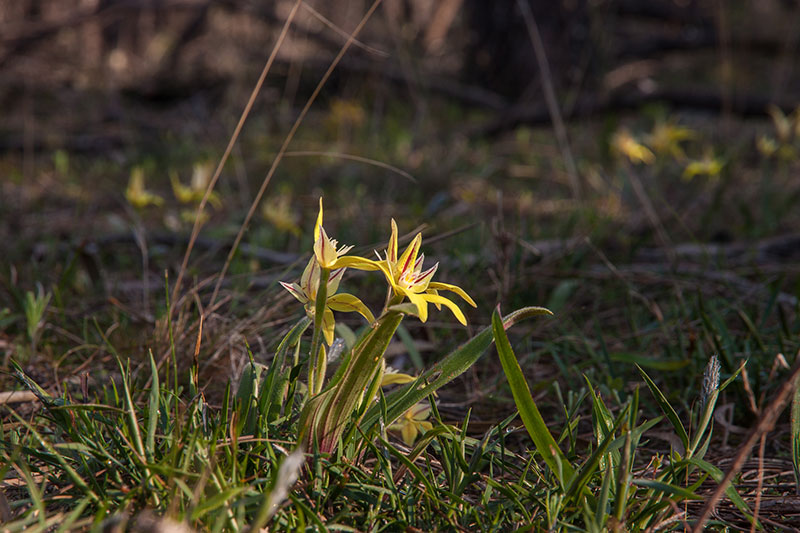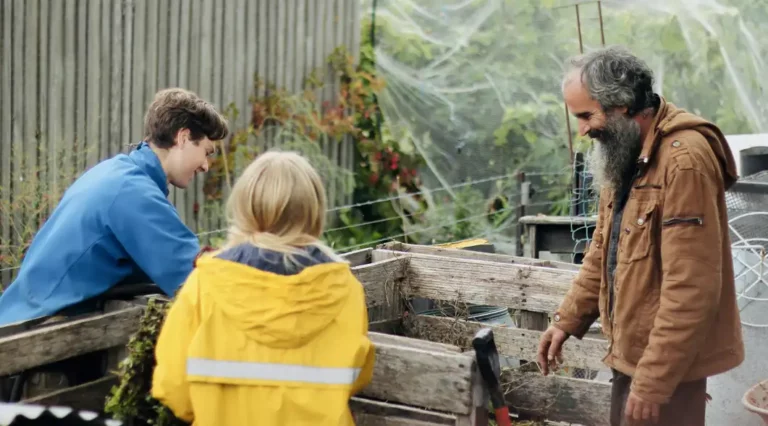Our plans for heading for home required us going back to the coast at Esperance before the journey north to Norseman and out across the Nullarbor. We had reluctantly decided that we couldn’t visit the various farmers from further west and south we had met in Gnarrojin but were curious about the biodynamic farm at Dumbleyung that were the source of Breadwrights old varieties of wheat that we had savoured baked in the oven at the Gnarrojin Community Garden.
Heading south to Wagin and then east to Dumbleyung, the crops had received more rain than around Gnarrojin, but the scale of both the salinity and revegetation work in the low lying parts of the landscape was staggering. Decades of landcare had certainly made an impact but tragically a significant part of the recovery of woody biodiversity may be due to the declining rainfall of recent decades slowing the groundwater recharge that drove the massive increase in salt following clearing of trees and perennial vegetation in the early 20 th century.
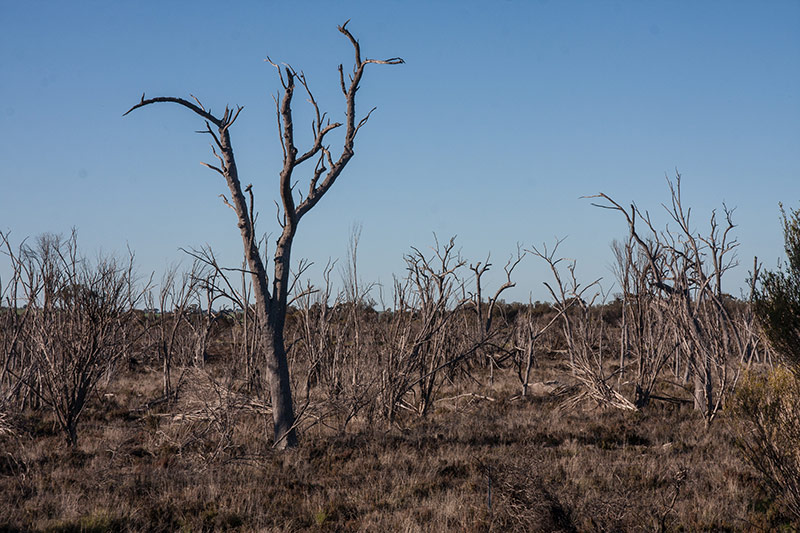
Large scale death of trees, including many salt tolerant species across the WA wheatbelt stimulated massive farmer and government supported revegetation that made many areas like this look just like another patch of bush to the casual observer
Lake Dumbleyung is the largest lake in WA, saline of course and dry more often than not, although it has overflowed 4 times in the last 100 years, contributing water to the Blackwood River catchment that enters the sea at Augusta. The short road along the fringing nature reserve to a lookout took us past magnificent fringing vegetation of high salt tolerant Casuarina obesa and majestic Swamp Yate (E. occidentalis). David got some great shots with mirror reflections but the clouds of mosquitoes and midges, combined with need to find a more suitable and legal campsite, had us move on – but not before David realised why the name Lake Dumbleyung seem so familiar from his childhood.
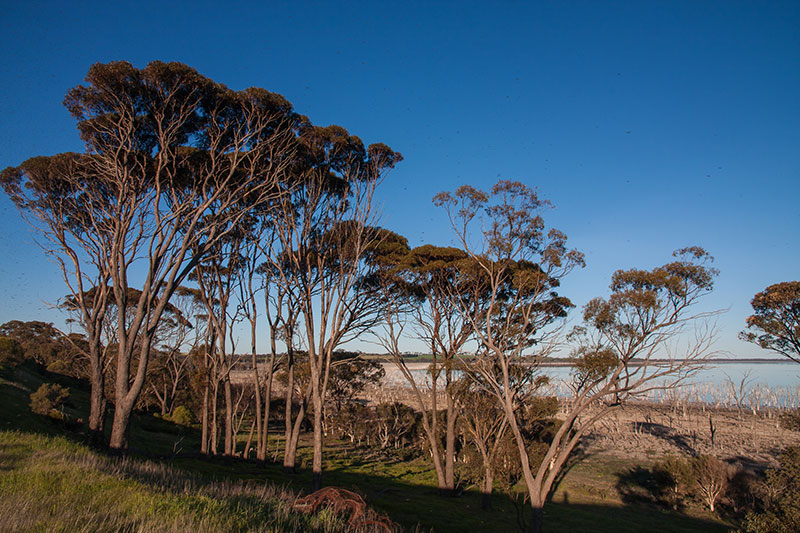
Lake Dumbleyung with E. occidentalis
This was the place where Donald Campbell broke the world speed record on water in 1964, the same year he broke the land speed record at Lake Eyre. Both vehicles were called Blue Bird, in a lineage of vehicles celebrating speed and daring dating back to the 1920s when his father Malcolm Campbell was breaking speed records. In 1964 when David was 9 years old this was very important stuff!
The camp south of Dumbleyung in a patch of bush on a hill next to a paddock of barley with great views to the southeast was another wonderful connection to remnant wheat belt flora. Next day we had a late pack up after Su made miso soup and a cabbage salad halfway between coleslaw and sauerkraut for lunch over the next days travelling. A walk around the bush revealed orchids, dryandras, incredible wandoo trees all packed into this small patch that included what appeared to be a recently abandoned gravel quarry.
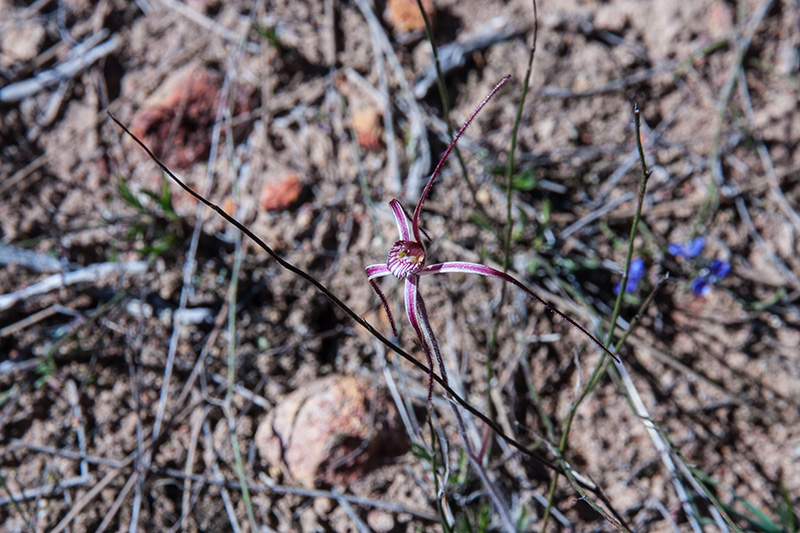
A spider orchid, one of the more inconspicuous wild flowers we saw
The patch was also home to a substantial mob of kangaroos that had done a neat job grazing the edge few rows of the crop. Not a substantial impact on a paddock that might have been hundreds of hectares, but no doubt an impact kept under control by shooting.
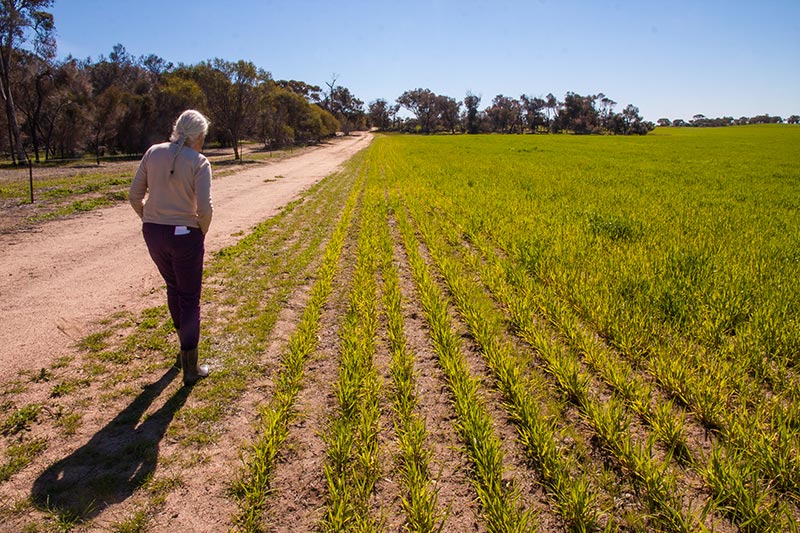
Su inspecting the neat edge crop grazing by the resident kangaroos of the patch of remnant bush where we camped
Back in town we made use of the internet (for a small fee) at the Community Resource Centre, in the absence of any phone service, got some basic supplies and checked out the replica Bluebird completed and on display to mark the 50 th anniversary of the Campbells breaking the speed record. David noted that the Bluebird fuel tank held near 3000 litres of kerosene to sustain its record breaking runs across Lake Dumbleyung, about double the fuel we will have used on our 14,000 km journey by the time we return home.

The Bluebird replica on show in the main street of Dumbleyung
After lunch siting on top of the camper in the very wide and quiet main street we headed out of town east past more giant new cropping equipment, massive green grain, some lupin and canola paddocks, saline samphire flats, huge Yate, Wandoo and Salmon Gums and heathlands with the most extraordinary diversity of form and flower. Lake Grace is a bigger regional centre and had a supply of high-octane fuel we needed for The Blue, which was not available in the town of Bluebird.

Grain header with ute for scale
Camp Tuesday night was near Newdegate in a linear heathland reserve that ran along a straight bitumen road where time between vehicles could be an hour or more. More grain fields and an incredibly diverse native vegetation adapted to soil without the nutrients needed to grow the crops.
The trip to Esperance took us through Lake King in the far east of the wheatbelt, then south to Ravensthorpe through varied soils and landscapes with more rainfall supporting taller crops. At Ravensthorpe, the greater agricultural productivity, long standing mines and highway one tourism based on the Fitzgerald River National Park biodiversity hotspot was a sharp contrast to the wheatbelt towns with empty buildings and declining economies.

A sculpture of Royal Hakea (H. Victoria), one of the iconic natives endemic to the Fitzgerald River National Park at the Ravensthorpe police station. Ironically the trees on the verge are “eastern states” red gums from an earlier period planted as fast growing trees
Having visited Fitzgerald River National Park in 1999, we decided to spend time on the coast further east. Along the highway the signs of phytophthora dieback in the native vegetation, especially the banksias, was evident, as was the increasing presence of naturalising species showing exotic vigour in their new environment. These included Radiata Pines and Blue Gums savaging coastal air moisture to add to the groundwater with less salinity than further inland. More significant in the longer term are the shelter plantings of Tuart (E. gomphocephala) from the Perth coastal plain, which we saw here fast growing and vigorous 20 years ago. This trip we saw them naturalising along with Acacia pycnantha from Victoria. Tagasaste, Spotted Gum and other eastern states Acacias occured in increasing numbers as we approached Esperance while the blocks of Pines and Blue Gum provided shelter in the open windswept paddocks of the south coast.

Shelterbelt of tuart standing as a single row against to the salt-laden southwest winds. Over 20m tall tuarts are four times the maximum height of the local native mallee vegetation and only about 50 years old
As we saw in Albany, an export woodchip stockpile for paper pulp reflected the low value bulk commodities this country produces rather than growing and value adding the capacity of the country to grow wood. At Esperance, Tuart and Spotted Gum are emblematic of the higher quality woods that thrive in this cooler coastal climate. The Norfolk Island Pines show the potential for plywood veneer production on sand subject to the strongest salt winds in landscapes that we should convert to forest in preparation for increased storm surges of a more challenging climate.
Arriving in Esperance we were down to shorts and t-shirts with the temperature on the coast at 27 0 C. We decided to camp in the most downmarket of the many town caravan parks to get power for batteries and other conveniences before we headed east along the coast. Setting up in the camp kitchen we had to contend with another resident watching the Channel 9 news, which amongst the banalities, reported 30 0 C being a record breaking winter temperature for Perth.
While photographing the roadside biodiversity and landuse along the 300km journey that day David mused on the contradiction between an agriculture driven to maximise yields of grain across vast tracts of country powered by fossil fuel and fertiliser, and the efforts to conserve and protect the regions extraordinary floral biodiversity. That agricultural economy ensures that the exquisite biodiverse ecosystems adapted to low fertility and minimal soil disturbance will continue collapse despite heroic efforts at conservation. While the hotspot of that biodiversity in the super low fertility quartzite country of Fitzgerald River National Park might hold out the longest against the inexorable impacts of the movement of soil pathogens, water, seed and nutrients, a heating climate will certainly push much of the biodiversity clinging to the cool hills and coastline off the edge.
David wondered if discussion by the global elite of biodiversity conservation had considered setting up a botanic reserve for the Fitzgerald River National Park cool climate endemic species on the same low fertility quartzite country of western Tasmania. Probably not, because many of the species would not stay put but would naturalise, and thus be considered invasive species in their new found home. Climate change promises to make mincemeat of the current “nativist” orthodoxy that underpins conservation biology and Landcare. In the meantime nature continues to mix it up, creating hybrid brews of ecologies by which she will ensure that some form of biological abundance will colonise the mess we have made of this frugal form of paradise.
<< Previous Chapter — — — Next Chapter >>
